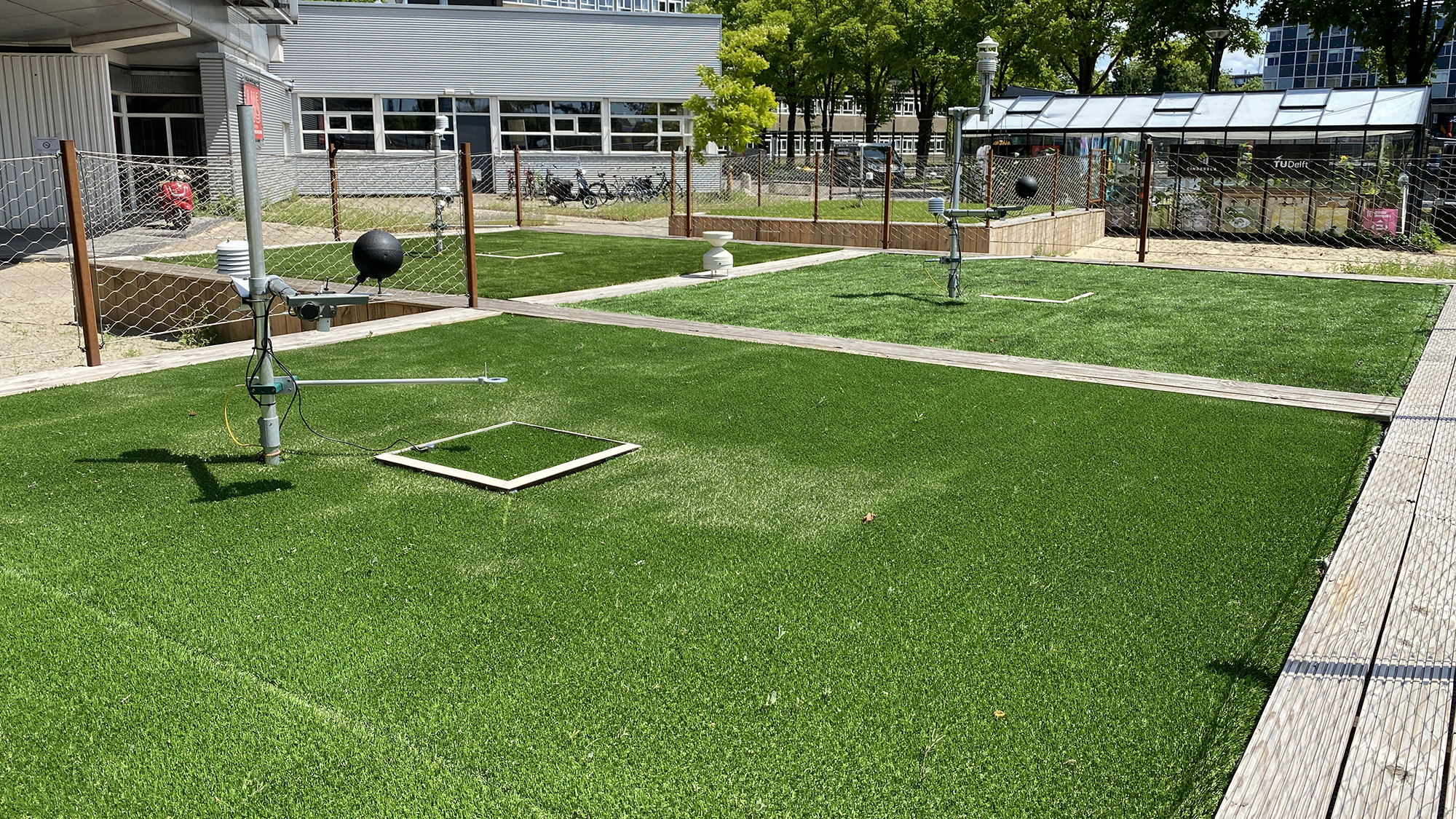
Picture of the field site in Amsterdam with the four research plots. Credit: Joris Voeten
Playing sports outdoors has gotten exceptionally toasty. Renowned international athletes recently contributed to a report saying extreme heat could pose safety risks during this year’s Paris Olympics. Just last month, the South American Football Confederation, following FIFA years earlier, officially altered its rules to account for “rising temperatures due to climate change.” These heat issues are poised to worsen as temperatures increase and more communities replace grass with easier to maintain artificial turf. Though more durable, artificial turf struggles to absorb and retain water which ultimately leads to higher surface temperatures, sometimes approaching 170 degrees Fahrenheit.
Researchers from the KWR Water Research Institute in the Netherlands tried to address these sweltering turf temperatures by creating a new, “evaporative-cooling” artificial material capable of collecting rainwater and using it to lower temperatures on the surface of a field. The research, published this week in Frontiers in Sustainable Cities, found that surface level temperatures on their custom turf was 46 degrees cooler than that of a contemporary artificial turf and close to the same temperature as natural grass. If implemented at scale, researchers believe this type of self-cooling turf could potentially reduce the risk of serious heat-related injuries and even help improve storm drainage in urban areas where rainwater isn’t absorbed well by traditional artificial turf.
“Including a subsurface water storage and capillary irrigation system in artificial turf fields can lead to significantly lower surface temperatures compared to conventional artificial turf fields,” KWR Water Research Institute hydrologist Marjolein van Huijgevoort said in a statement. “With circular on-site water management below the field, a significant evaporative cooling effect is achieved.”
Evaporated rainwater can make turfs nearly as cool as natural grass
Natural grass is typically preferable to artificial alternatives both in terms of cooling and water drainage because water can organically seep into soil. Sporting fields, and even an increasing number of parks, however, have pivoted towards artificial turf in recent years due to its ease of maintenance. The researchers used grass’ natural water absorption as inspiration and created their own turf with an open water storage layer tucked directly underneath the surface turf and shock pad. That water layer captures and stores rainwater. Capillary cylinders made up of hydrophilic rockwool fibers are then used to transport the water back up to the surface where it evaporates. In the end, the evaporated water naturally cools the turf surface.
Researchers tested their self-cooling turf against traditional turf and natural grass on a warm, sunny summer day in The Netherlands in 2020. Surface temperatures on their self-cooled turn clocked in at 98 degrees Fahrenheit. That’s hot, but nothing compared to the traditional turf which measured in at a whopping 144 degrees Fahrenheit. On top of that, the self-cooling turf was nearly the same temperature as the natural grass plot, which read 101.6 degrees Fahrenheit.
 Overview of the water retention system below the artificial turf field. Credit: Permavoid
Overview of the water retention system below the artificial turf field. Credit: Permavoid
Though other research has previously looked into cooling artificial turfs intermittently with sprinkler systems, that typically only provides limited, short-term cooling relief. Constant sprinkling can also damage or impair the playability of the turf for sports. The KWR researchers say this new approach improves on those efforts by storing naturally occuring rainwater to cool a field when needed. The self-cooling turf also reportedly resulted in slightly cooler temperatures above the field surface. In addition to the cooling effects, researchers say the water-absorbing pitch could also help reduce stormwater drainage which in turn could combat urban flooding. Lackluster drainage systems and a glut of concrete have reportedly contributed to a rise in storm-related flooding in recent years.
Researchers say their novel cooling system is relatively straightforward to implement, but it’s not necessarily cheap. Installation costs for a self-cooling field could add up to roughly double that of traditional turf. And while the experiment focused on small 5X5 meter plots of turf, fields in the real world could easily eclipse that. Still, those upfront costs may only tell part of the story. Heat stroke and other health-related harms or agriculture damage resulting from poor drainage bring in long-term costs of their own that, in theory, could potentially be mitigated with cooler turf at scale.
“The investment needed for a cooled standard field is higher than for a conventional field,” the researchers write. “This investment, however, allows the pitch to become part of the on-site water management regime and forms a cooler and safer pitch for the athletes, based on natural evaporation of retained (instead of drained) rainwater.”
>>> Read full article>>>
Copyright for syndicated content belongs to the linked Source : Popular Science – https://www.popsci.com/technology/artificial-turf-self-cooling/































